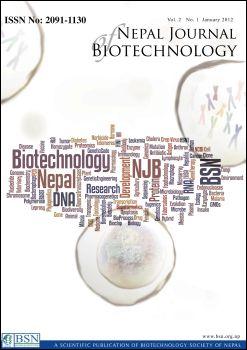Genetic Relationship among Nepalese Rice Landraces and Cultivars based on RAPD Markers
DOI:
https://doi.org/10.3126/njb.v2i1.5635Keywords:
Genetic distance, rice, RAPDAbstract
Genetic information of any genotype is necessary to manage and utilize them in conservation and breeding program. A total of 28 RAPD markers were used to relate the genetic structure among 50 Nepalese rice genotypes consisting of 29 landraces, 12 breeding lines and 9 released cultivars. Some of them are aromatic and blast resistance. Only four primers (P41, P60, P109 and P141) amplified the DNA of these genotypes with scorable bands. Primer 60 produced the highest number of bands (8). The highest number of present bands (6) was shown by primer 41 in 10 rice genotypes. Grouping of these genotypes based on the adaptation to agro-climatic zone was not observed, probably due to low percentage coverage of genome by four primers. Most of the genotypes grouped in two clusters. Kali Marsi and IR-24 formed separate individual cluster. Mansara and Jarneli were the most similar landraces (0.96). Churenodhan and Pranpyuri were the most closely related with Masuli. Only one genotype NR-285-18 has fallen in the first quadrant by principal component (PC) analysis and the fourth quadrant was empty. The highest contribution in PC1 was from the second band of primer 41. This RAPD information can be used for selecting lines and for blast resistance breeding.
Key words: Genetic distance; rice; RAPD
DOI: http://dx.doi.org/10.3126/njb.v2i1.5635
Nepal Journal of Biotechnology Jan.2012, Vol.2(1): 16-25
Downloads
Downloads
How to Cite
Issue
Section
License
Copyright Notice:
The manuscript submitted to NJB must be an original contribution, not previously published and should not be under consideration for publication elsewhere. When the manuscript is accepted for publication, the authors agree to automatically transfer the copyright of the article to the publisher. It should grant permission to any third party, in advance and in perpetuity, the right to use, reproduce or disseminate your article, according to the NJB copyright and license agreement.
Authors transfer copyright to the publisher as part of a journal publishing agreement but have the rights to: Share their article for Personal Use, Internal Institutional Use and Scholarly Sharing purposes, with the NJB applies the Creative Commons Attribution-NonCommercial CC BY-NC license to all the works we publish after Jun 2020 (Before it was CC BY-NC-ND). Under this license, authors agree to make articles legally available for reuse, without permission or fees, for virtually any non-commercial purpose. Anyone may remix, adapt, and build upon your work non-commercially, and although their new works must also acknowledge you and be non-commercial, they don’t have to license their derivative works on the same terms. More details on CC BY-NC refer to its Licence Deed and Legal Code.






